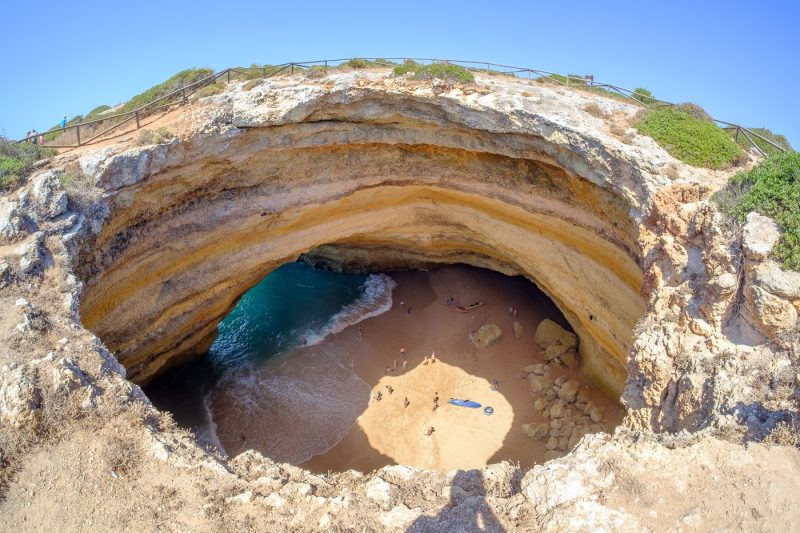While once a forgotten place in Western Europe, Portugal has been on the rise when it comes to tourism. Attracting millions of people every year to the mainland and its two islands, Portugal is now one of the best vacation destinations in Europe.
You might be surprised to learn that Portugal has thousands of beaches. Being the westernmost European country, it means that most of it borders the Atlantic Ocean. Depending on where you go, you’ll find very different beaches. Check out of travel tips for the best beach areas in the region!
Where to go, what to see?
The north of Portugal has plenty to offer. It’s a small piece of paradise dropped onto the doorsteps of Europe. There are thick forests, pebble beaches, incredible waterfalls, and exciting hiking trails that have tall mountains as a backdrop.
The south of Portugal sees the most of visitors every year. People come from all over the world to see the beautiful long beaches the Algarve has to offer. Everything from the golden sand to the dramatically-cut cliffs dazzle visitors and make them want to come back year after year.
But even the capital has beautiful beaches. A very short train ride will lead you from Baroque-style monuments to charming gold-sand beaches bathed by the blue waters of the Atlantic Ocean.
And who could forget the islands? There are two archipelagos in the Atlantic waters: Madeira, and the Azores.
Most of the population in Madeira lives on just one island. It’s known for having great climate year-round, rich history and traditions, and spectacular beaches with golden sands.
The Azores, on the other hand, is made up of seven islands. Here, the climate is more on the tropical side, since most days go through the four seasons of the year: spring, summer, winter, and fall. The thing it’s most famous for is its breathtakingly beautiful natural sites. From extinct volcanoes with natural hot pools to dense forests, the Azores are a dream come true.
If you’re planning your vacation now, keep these Portuguese beauty spots in mind. They’re beautiful, easily accessible, some of the safest in the world, and conveniently placed between the Atlantic and the rest of Europe. Plus, a week in Portugal is enough to hit some of the coastline in the country without getting burned out.
North of Lisbon
1. Praia Forte do Paço, Viana do Castelo
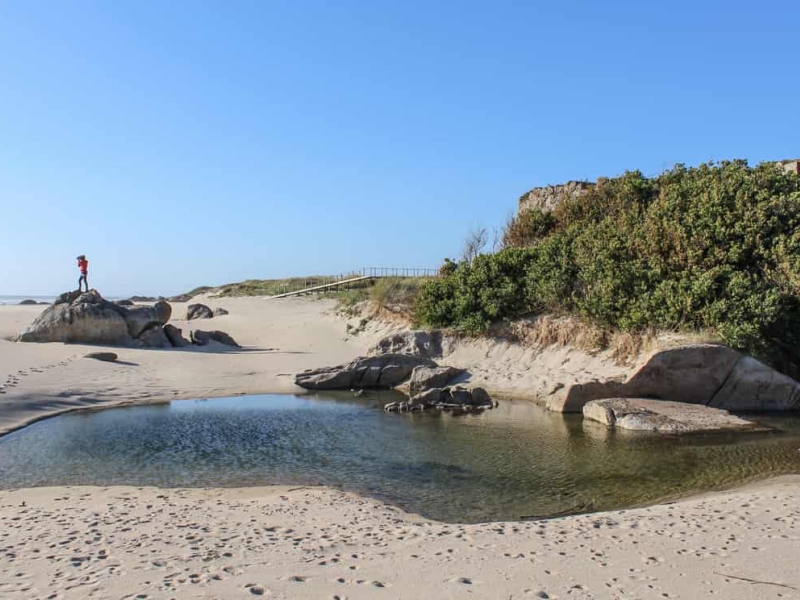
Just one hour away from Porto lies Praia Forte do Paço, a sandy beach in the north of Portugal. Here, rocky hills give way for sand dunes, sandy coves, and hidden beaches. Here’s a travel tip: it’s the perfect place if you want to get away from the crowds.
Even in the summer months, Praia Forte do Paço is much quieter than any of the neighboring beaches. It owes its name to the 18th-century fort nearby that once defended the coast of Portugal from seaborne invasions. Now, it’s abandoned and a great place for children to play pirates — and, of course, for adults to explore!
The beach itself measures half a mile, but since it doesn’t see many visitors, you’ll feel like it’s a much longer beach. The sand is fine and golden, perfect for long walks on the beach at sunset.
The sea waters are cold. After all, this is the Atlantic Ocean, not the Caribbean Sea. But since the sea is calm, brave swimmers are welcome to take a dip and swim around here. Small children love playing in the granite natural pools that fill up with every crashing wave. The water tends to be warmer here and parents can rest assured that the little ones won’t get hurt.
As there are no beach bars or restaurants, you’ll have to pack your picnic. But don’t worry, the cliffs and trees give great shade as a shelter to the blazing hot sun.
Near Lisbon
2. Praia do Norte, Nazaré
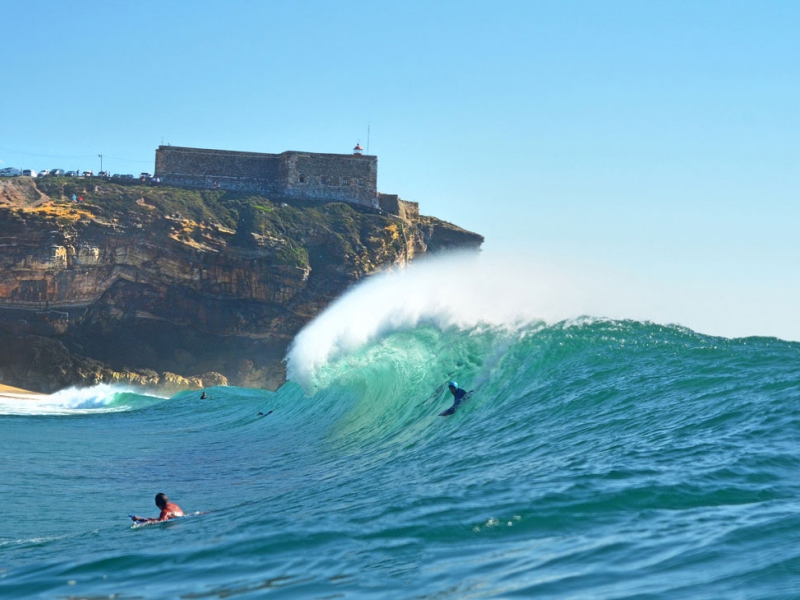
Praia do Norte has a major selling point that most beaches around it don’t: it boasts some of the best waves in the world for surfing year-round.
You might have heard about Nazaré and before if you follow surfing news. The tallest wave ever surfed broke right here on this beach when Garrett McNamara, undoubtedly one of the best surfers in the world, rode a 100-foot-tall wave in 2013.
The underwater canyon known as Nazare Canyon is responsible for creating these monumental waves year-round. It draws in hundreds of brave ambitious surfers looking to get their name on the Guinness World Records book by surfing the tallest wave ever. This underwater canyon is a very rare geological phenomenon, and it’s the biggest one in Europe and among the biggest in the world.
Praia do Norte stands out because of the waves, but the beach town of Nazaré is also worth paying a visit to. The surfer community here is very active and tight-knit. Life in Nazaré is laid back and heavily focused on the sea, since the region makes most of its money from fishing and from tourist-related sea activities.
It’s also easily accessible from Lisbon. If you want a break from exploring the city and get the opportunity to ride big waves, Praia do Norte is the place for you.
3. Praia do Guincho, Sintra
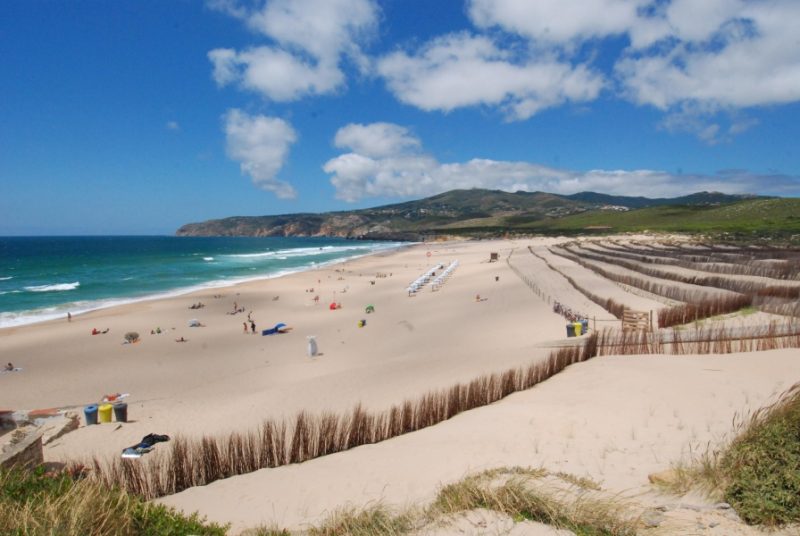
Nestled between the quaint town of Cascais and Serra de Sintra, a national park that is the city’s biggest oxygen producer, is Praia do Guincho. Tucked away between tall and dramatically-cut cliffs, this is one of the best surfing beaches in Portugal.
Praia do Guincho is notorious for its tall waves and strong winds. Besides surfers, windsurfers, kitesurfers, and the likes, no one comes here. It’s definitely not a beach where you’d want to swim if you don’t have a lot of experience, since it has strong currents and the water is icy.
The beach itself is very large. The sand is soft and white and there are sand dunes at the back of the beach. If you’re traveling from Lisbon, getting here is no hassle. You can take a bus or a train and walk for a short amount of time and voilà — you’re at one of the best beaches in Portugal for water sports.
If you’re driving, coming here feels even better. You can take a road trip from Praia do Guincho to the Sintra National Park and to the neighboring fishing villages. You could even drive up to the westernmost point in all of Europe: Cabo da Roca.
But if you’re staying in the area and would like to sunbathe away from the gushing winds, you can do so at the Atlantic Ocean Pool. This artificial pool was built inside of a makeshift fort and is filled with water straight from the ocean. It’s a great place to escape the wind, currents, and waves from the Atlantic.
4. Praia de Carcavelos, Cascais
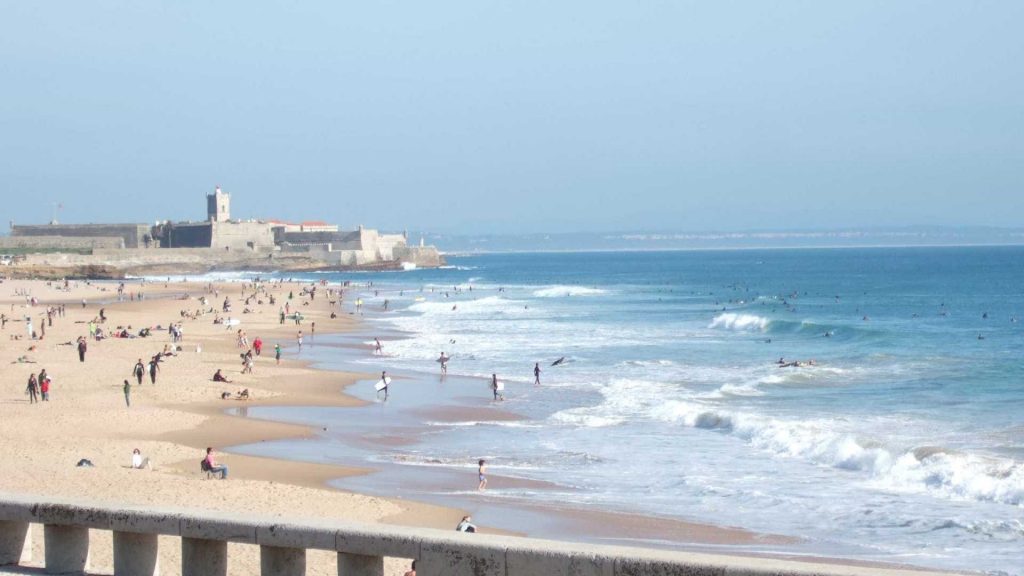
Right on the doorsteps of Lisbon sits Praia de Carcavelos. Getting here from the Lisbon city center couldn’t be easier: simply take the train to Carcavelos and walk for 5 minutes until you have your toes in the sand.
Praia de Carcavelos is a vast and golden sand beach where locals come during the weekends and public holidays. As soon as the sun comes out, you’ll see people flock to the sandy stretch of coast that is Carcavelos.
There aren’t any cliffs or sand dunes adorning this beach, but who needs those when there is a pedestrian-only sidewalk where you can jog, walk, run, or cycle while overlooking the bright blue Atlantic Ocean? Praia de Carcavelos is the best place to people-watch in Lisbon.
Young people are the biggest lovers of this beach. Every summer the beach gets packed in the afternoon with students that are on break. But they’re not the only ones to come here during the hottest months. Families with children come here all the time to escape the heat in the city. Since this is an easy-to-reach beach with lifeguards around and plenty of space to lay your towel and umbrella, it’s a family-friendly beach destination.
Lastly, the cool and chic villa of Cascais is nearby. Once a destination for wealthy Portuguese families and expats during the 20th century, Cascais has never lost its charm over the years and it still very much has that beach town feel for which it’s loved.
South of Lisbon
5. Praia da Comporta, Troia Peninsula
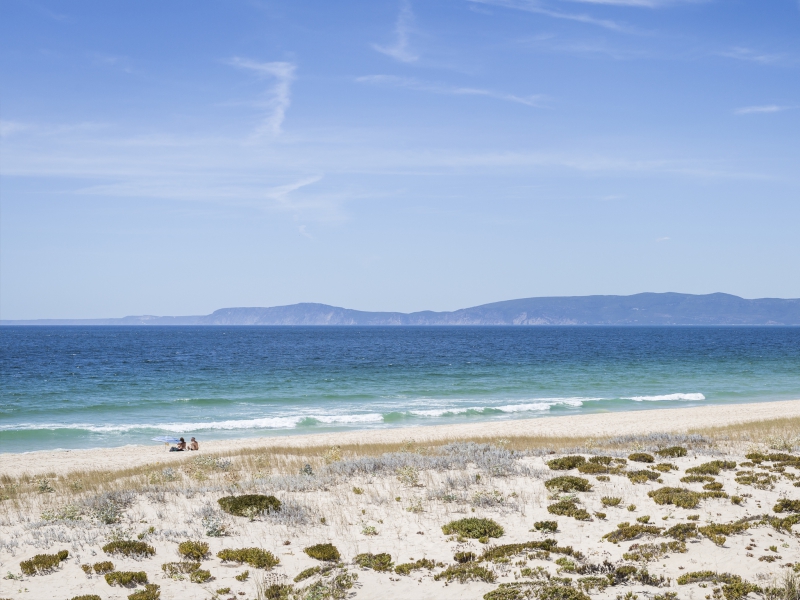
It’s hard to describe the beaches in the Troia Peninsula without using the word “paradisiac.” And Praia da Comporta easily fits that description. It’s no wonder wealthy families have been coming down here to spend a summer weekend for generations now.
The powdery white sands of Comporta Beach trick visitors into thinking they’re actually in a tropical beach somewhere in South America or the Caribbean. The deep crystal clear waters with their characteristic hint of blue and the stunning birds and dolphins that call Troia home also help you forget you’re actually in Europe.
Measuring a total of 11 miles from one end to the other, the Troia Peninsula is a place straight out of a fairy tale. Comporta is the most famous beach destination here and certainly worth paying a visit to. Plus, it only takes visitors around an hour and a half to reach it from the Lisbon city center.
This is a perfect place for a long walk on the beach. With ocean vistas to die for, it’s hard to find a more Caribbean-like beach in Portugal. You can also go swimming since the waters of the Atlantic are very calm here. They’re also clear, so if you like exploring the sea bottom, you can happily do so.
On the opposite end of the peninsula lays the Sado Estuary. This government-protected park is a source of biodiversity exclusive to Portugal. Thousands of birds start their thousand-mile migratory journey from here, a place where they also mate and nest. Bird watchers will love the diversity of bird species you can find in this estuary.
While you’ll see a lot of luxury estates, fancy restaurants, and upscale hotels and resorts in Troia, this place still feels very much off-the-beaten-path. If you’re after a relaxing holiday under the sun in a paradisiac beach, look no further. Praia da Comporta is, hands down, one of the best Portugal beaches.
6. Praia da Franquia, Vila Nova de Mil Fontes, Costa Vicentina, Alentejo
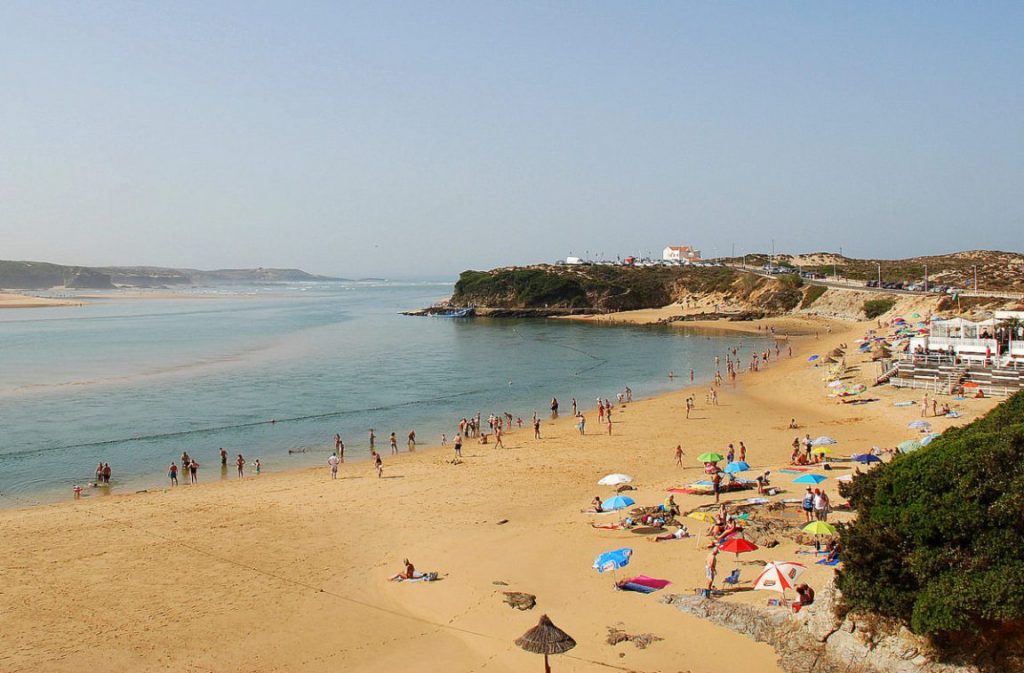
This sleepy beach town is located in the most scarcely populated district of Portugal: the warm, desert-like Alentejo. It comes alive in the summer months and it’s the ideal beach destination for those who want to see nature and get away from the crowds.
Praia da Franquia is a beach located on the Costa Vicentina, the place where Alentejo and the Atlantic meet. This Natural Park is a hidden gem most visitors fail to visit in the country, but those who do come here are amazed by all the natural beauty of the park. It stretches out for almost 70 miles and is home to hundreds of plant and animal species.
The park is easily accessible from all beaches in Vila Nova de Mil Fontes, including Praia da Franquia, and boasts dozens of hiking trails. People who like walking in nature will have found their haven here. Going over cliffs and through dried out fields with some desert plants here and there, the nature trail is out of this world.
The beach itself is also a gem. Unlike most beaches in the south of Portugal, Praia da Franquia is a mix between a river beach and an ocean beach. The Mira River flows into the Atlantic Ocean here, making the waters clear, calm, and not as chilly as in other beaches in the region. The sand is fine and golden here, as it is in the rest of the Costa Vicentina.
This is a very family-friendly beach. The waters are shallow and calm, perfect for children to play in. There are also some beach bars and restaurants right on the beach, so you don’t have to worry about packing a picnic.
7. Praia de Odeceixe, Costa Vicentina
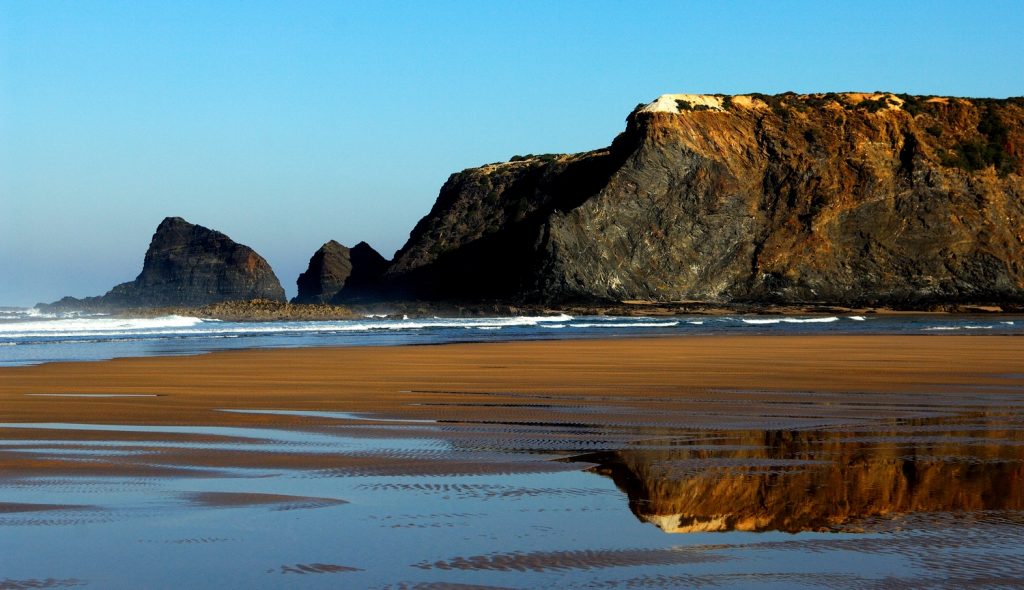
Odeceixe is a sleepy town that is divided into two by the Seixe river, marking the border between the Alentejo region and the more touristy Algarve region. It’s during the summer that this town and the beach truly come alive.
As soon as the temperatures rise up and the sun starts to shine, surfers, swimmers, and sunbathers are drawn here every year without fail. Being one of the most sheltered beaches in the area means little to no wind and calmer sea waters.
There’s also a river that feeds into the sea right in the middle of Praia de Odeceixe. Children can play around in the cool and calm waters of the river which is safer to swim in than the ocean is.
The views from the beach are also spectacular. The imposing black cliffs are fall dramatically into the sea, adding beauty to an already stunning stretch of sand.
On the south side of the golden sandy beach, there’s another one called Adega Beach. You can easily get there by foot from Praia de Odeceixe when the tide is low. It makes for a dynamic and very interesting walk on the beach.
The waters of the Atlantic Ocean here are calm and safe enough to swim. Surfers and kite-surfers will also enjoy the vast blue sea that bathes the beach here. The waves are great even for beginners of the sport. Sailing is also a popular activity among beachgoers that come here.
If you care to find out more about the culture of the Algarve and Alentejo, Odeceixe is great for that. One of the cutest Portugal beach towns is located just over two miles from here and has great restaurants, bars, beach rentals, souvenir stores, and much more. You can count on finding good, fresh fish here. It makes for a great end-of-the-day meal.
All these activities, the good and easy accesses to the beach, and the calmness you’ll see here make this an awesome family-friendly beach you won’t forget about so soon.
The Algarve
8. Praia da Marinha, Lagoa
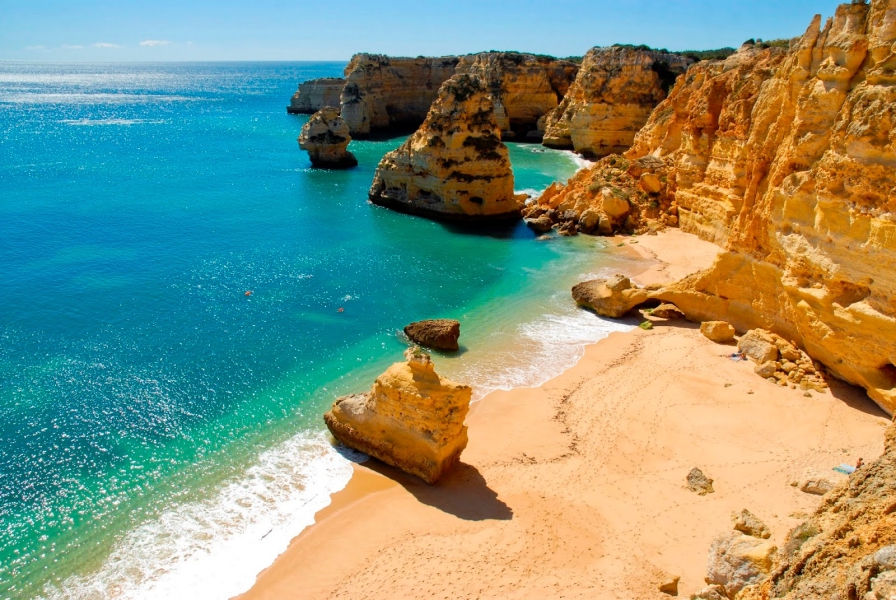
This must be one of the most typical and amazing beaches in the Algarve. Not only is Praia da Marinha constantly voted one of the top beaches in Portugal, it’s also on the top beaches list in Europe.
Praia da Marinha is nestled between tall and majestic-looking colorful cliffs. You can clearly see different layers of different shades of white and yellow here. But unlike what happens in most beaches, the cliffs don’t just end where the water starts. They also dot the water creating little coves and secret spots that beg to be explored.
The sand here is very fine and golden yellow. Perfect for walking from one end of the beach to the other and for exploring the sea bottom when the tide is low.
One of the biggest selling points that this beach has is the fact that the waters are crystal clear and a beautiful shade of blue. It’s a great idea to bring your snorkeling gear because you can see so well underwater with it on. Swim up to the rock formations and see if you can spot any underwater animals living there.
Another advantage this beach has is that it’s not as crowded as neighboring beaches. Since you can only reach it by car and then by going down a lot of steps, not too many people come here even during the summer months.
9. Praia da Rocha, Portimão
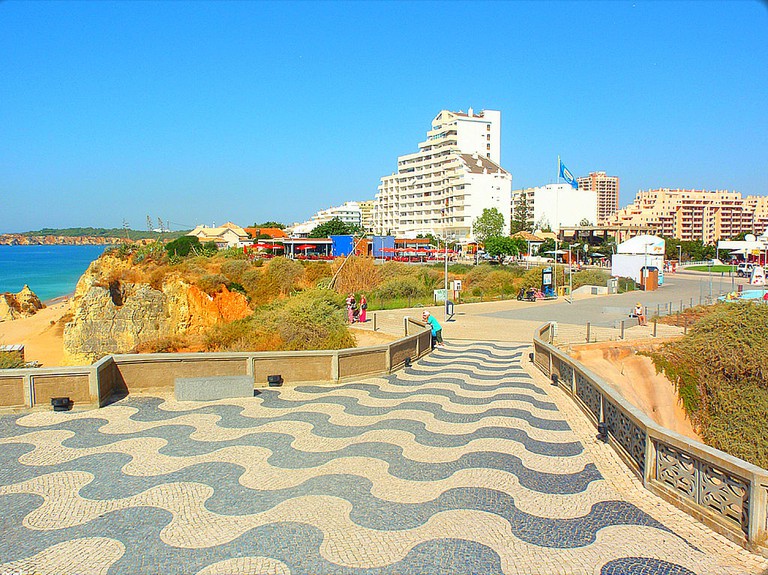
Probably the most convenient beach in Portugal, you’ll soon realize why there are so many visitors here and yet it doesn’t feel crowded at all. It’s all about it being incredibly vast and long — what else could you ask for from a touristy beach destination?
Located in one of the liveliest and tourist-friendly cities in the Algarve, Portimão, Praia da Rocha is family-friendly and a very popular meetup spot for young Portuguese people. The beach measures more than 2 miles from one end to the other and there are passageways that lead you to the adjacent beaches.
People come here for the fine golden sand, the calm waters of the Atlantic Ocean, and for the conveniently placed beach bars, restaurants, and stores. As soon as you get hungry, there’ll be a handful of nomad food sellers offering local traditional pastries, including the ever-famous and much-loved Bolas de Berlim. You’ll also have a vast choice of cuisines: anything from Irish pubs to Indian restaurants to traditional Algarve cuisine.
You can swim here pretty easily. Every year the beach has been awarded the blue flag, meaning that the waters are super clean and safe to swim in. There are also lifeguards always present here during the summer season.
Alternatively, you can rent paddle boats that fit up to 6 people from one of the stands here. It’s perfect to see the beach from a different perspective, get some exercise in, and feel like a sailor even without having any experience whatsoever.
10. Praia de Benagil, Carvoeiro
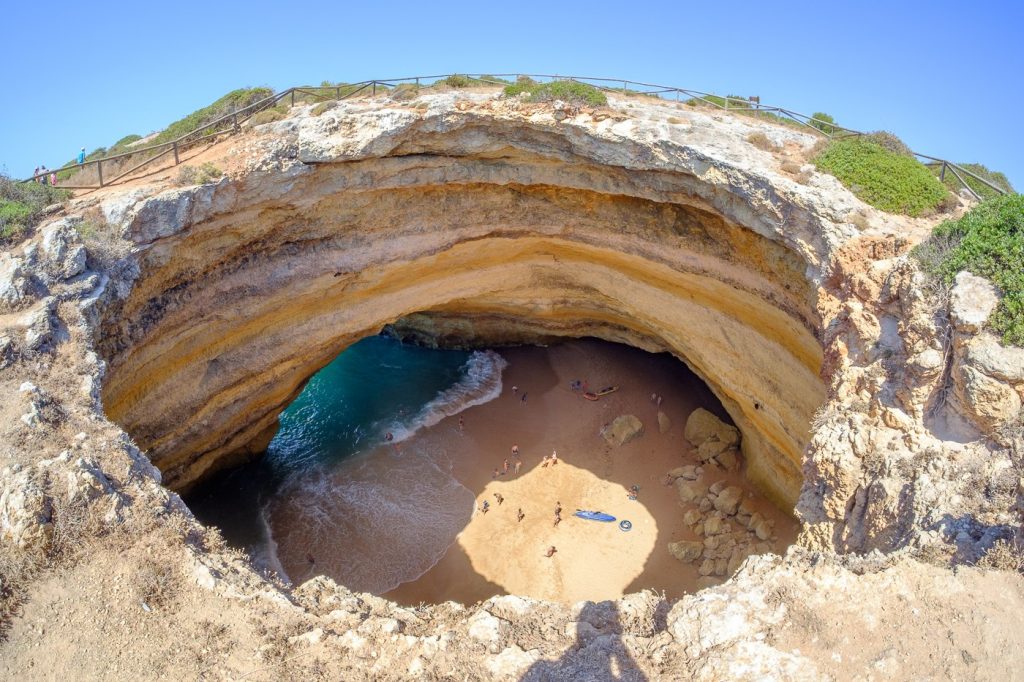
We’re sure that you’ve seen pictures of this beach if you’ve looked up “beach coves” and “sea caves” online. It’s one of the most iconic Algarve beaches (and, well, Portugal beaches, too) and one of the most photographed in the country.
Praia de Benagil is located on a small fishing village that still, to this day, lives off of the fishing industry. Every morning, fisherman head out to sea in their boats (big and small) to get the catch of the day. It’s thanks to them that Carvoeiro restaurants have such good fresh-fish dishes on the menu.
The sand here is fine and golden, while the sea is calm, a beautiful shade of blue, and has little to no waves. The entire beach is surrounded by the typical Algarve cliffs that make for great views. When the tide is low, you can actually explore many of the coves that the sea has carved out over the years.
But the main attraction in Praia de Benagil and what makes it stand out the most isn’t the beach. It’s a geological formation known as Algar de Benagil. This grotto is a large and tall rocky structure that has a circular hole on the roof. This means sunlight can come in and light up the otherwise-dark cove. Come here and wonder with your fellow visitors just how Mother Nature was capable of creating this almost-perfect ceiling opening.
You can only access the grotto by boat, so keep that in mind. Because of this and because parking is limited around the beach, Praia de Benagil isn’t nearly as crowded as other Carvoeiro, Algarve, and other Portugal beaches.
11. Praia do Camilo, Lagos
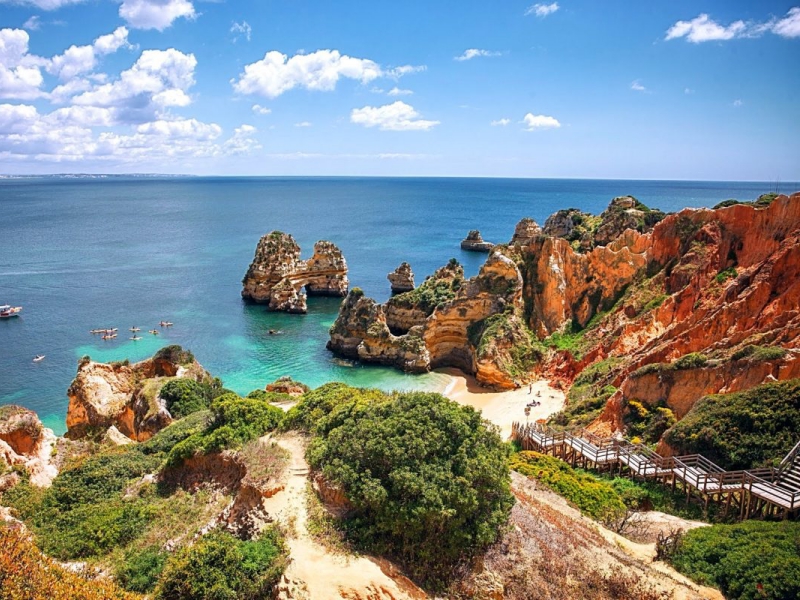
One of the most picturesque and best beaches in Portugal is located here in Lagos, a town that’s built on a hill. Praia do Camilo is small but packed with beauty everywhere you look.
Stretching out for less than a mile, it’s hard to find a more gorgeous beach than Praia do Camilo. It’s not easy to access, as you’d need to go down 200 steps until your feet hit the sand. But every visitor who has faced the climb down (and up) agrees that it’s totally worth it, even if it’s quite the workout.
Like most beaches in the Algarve, Praia do Camilo is nestled between sandstone cliffs. But unlike others, the craggy cliffs here are more ragged. This doesn’t make this beach any less beautiful or suitable for swimming — quite the contrary! They shelter the beach, which means that the Atlantic Ocean here doesn’t have strong currents or tall waves.
Swimming is a popular summer activity at Praia do Camilo. The high cliffs and the rock formations that are partially underwater turn the sea into a swimming pool of sorts. It’s definitely a unique experience, as not that many beaches have this feature.
If you’re looking for a bigger beach that also has a similar vibe and scenery as this one, head out to the neighboring Praia Dona Ana. Visitors constantly rave about this beach on TripAdvisor, which has made it win the Best Beach Choice Awards a number of times. Dona Ana Beach is the perfect family-friendly beach, since it has better accesses and small children don’t have to be carried or walk down and up 200 steps.
Another fantastic Algarve alternative is the Praia da Falesia beach which constantly racks up 5-star reviews and best beach ratings. The Praia da Falesia is a beautiful stretch that offers impressive disable access despite the intimidating terrain. We didn’t include the Praia da Falesia on our list because if we listed every Algarve beach we’d run out of room!
Best Portugal Beaches: FAQ
Does Portugal have beaches?
Definitely! Portugal borders the Atlantic Ocean from the north all the way to the south. This means that there are, in total, more than one thousand miles of coast. Can you imagine just how many beaches there are?
Are the beaches safe?
Portugal ranks, year after year, among the safest countries in Europe and in the world! It has been in the top ten list for safety for decades now. With Europe being in such a high level of fear for terrorist attacks, Portugal has never been targeted and lays peacefully in the westernmost part of Europe. You don’t have to be scared of any wars, terrorist attacks, or internal security alerts as Portugal is incredibly safe.
When it comes to swimming on a Portuguese beach, do so peacefully. During peak season most beaches have lifeguards on duty. Plus, if the waters aren’t safe to swim in, there’ll be signs written in English and Portuguese warning you. But since most beaches (or at least the most popular ones) don’t have strong currents, you’re going to be fine bathing here.
Does Lisbon, Portugal have beaches?
Yes! Lisbon is a coastal city with a lot of beaches you can visit. Our favorite Portugal beaches near Lisbon include a number of highlights. The Linha de Cascais (coastline of Cascais) has dozens of beautiful beaches. And the best part is that they’re easily accessible by public transport. The train will lead you from the city center to the beaches in less than thirty minutes.
If you want to venture off and cross the Tagus river, you can do so as well by taking a bus. It takes on average 45 minutes to get to the beaches on the southern bank. Visit the Costa da Caparica beaches for beautiful views of Lisbon and for calm waters. Good Lisbon beaches are easy to find!
Does Portugal have nice beaches?
Without a doubt! Portugal has a handful of beaches ranked in the top one-hundred most beautiful beaches in the world and feature very highly on most online travel guide websites. But even if they’re not in the ranking, they’re still worth checking out.
Are Portugal beaches cold?
If you were expecting beaches as warm as the ones in the Caribbean, you’ll be disappointed. The Atlantic Ocean isn’t warm at all here on Portugal beaches. The waters reach their highest temperatures in mid-summer, but it still takes some courage to get into the sea.
Does Portugal have sandy beaches?
Most beaches in Portugal are sandy. There are a few pebble beaches north of Lisbon, but they’re in the minority.
When is the best time to visit Portugal?
The best time to visit Portugal and its beaches is during the summer. The temperatures start to rise and the sun shines the most May through the end of September. Portugal has a very hot and dry climate during these months, so chances are you’ll never see a cloud in the sky during this period. Check your Portugal guide book to avoid disappointment!
